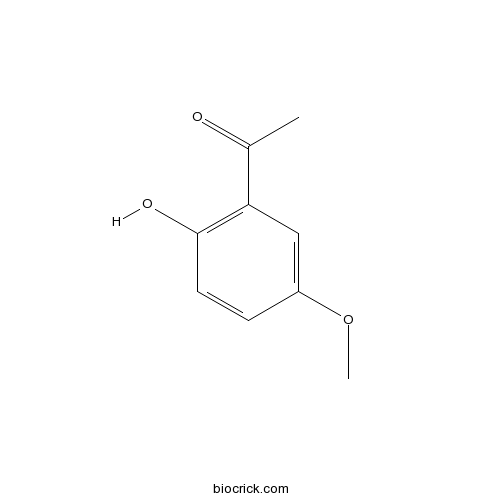2'-Hydroxy-5'-methoxyacetophenoneCAS# 705-15-7 |

Quality Control & MSDS
3D structure
Package In Stock
Number of papers citing our products

| Cas No. | 705-15-7 | SDF | Download SDF |
| PubChem ID | 69714 | Appearance | Powder |
| Formula | C9H10O3 | M.Wt | 166.2 |
| Type of Compound | Phenols | Storage | Desiccate at -20°C |
| Solubility | Soluble in Chloroform,Dichloromethane,Ethyl Acetate,DMSO,Acetone,etc. | ||
| Chemical Name | 1-(2-hydroxy-5-methoxyphenyl)ethanone | ||
| SMILES | CC(=O)C1=C(C=CC(=C1)OC)O | ||
| Standard InChIKey | MLIBGOFSXXWRIY-UHFFFAOYSA-N | ||
| General tips | For obtaining a higher solubility , please warm the tube at 37 ℃ and shake it in the ultrasonic bath for a while.Stock solution can be stored below -20℃ for several months. We recommend that you prepare and use the solution on the same day. However, if the test schedule requires, the stock solutions can be prepared in advance, and the stock solution must be sealed and stored below -20℃. In general, the stock solution can be kept for several months. Before use, we recommend that you leave the vial at room temperature for at least an hour before opening it. |
||
| About Packaging | 1. The packaging of the product may be reversed during transportation, cause the high purity compounds to adhere to the neck or cap of the vial.Take the vail out of its packaging and shake gently until the compounds fall to the bottom of the vial. 2. For liquid products, please centrifuge at 500xg to gather the liquid to the bottom of the vial. 3. Try to avoid loss or contamination during the experiment. |
||
| Shipping Condition | Packaging according to customer requirements(5mg, 10mg, 20mg and more). Ship via FedEx, DHL, UPS, EMS or other couriers with RT, or blue ice upon request. | ||
| Description | 2'-Hydroxy-5'-methoxyacetophenone [LD50 =1.03 μg/cm(2)] shows acaricidal potentials against D. farinae. |
| Targets | Antifection |
| In vitro | Acaricidal potentials of active properties isolated from Cynanchum paniculatum and acaricidal changes by introducing functional radicals.[Pubmed: 23855621]J Agric Food Chem. 2013 Aug 7;61(31):7568-73.
|

2'-Hydroxy-5'-methoxyacetophenone Dilution Calculator

2'-Hydroxy-5'-methoxyacetophenone Molarity Calculator
| 1 mg | 5 mg | 10 mg | 20 mg | 25 mg | |
| 1 mM | 6.0168 mL | 30.0842 mL | 60.1685 mL | 120.3369 mL | 150.4212 mL |
| 5 mM | 1.2034 mL | 6.0168 mL | 12.0337 mL | 24.0674 mL | 30.0842 mL |
| 10 mM | 0.6017 mL | 3.0084 mL | 6.0168 mL | 12.0337 mL | 15.0421 mL |
| 50 mM | 0.1203 mL | 0.6017 mL | 1.2034 mL | 2.4067 mL | 3.0084 mL |
| 100 mM | 0.0602 mL | 0.3008 mL | 0.6017 mL | 1.2034 mL | 1.5042 mL |
| * Note: If you are in the process of experiment, it's necessary to make the dilution ratios of the samples. The dilution data above is only for reference. Normally, it's can get a better solubility within lower of Concentrations. | |||||

Calcutta University

University of Minnesota

University of Maryland School of Medicine

University of Illinois at Chicago

The Ohio State University

University of Zurich

Harvard University

Colorado State University

Auburn University

Yale University

Worcester Polytechnic Institute

Washington State University

Stanford University

University of Leipzig

Universidade da Beira Interior

The Institute of Cancer Research

Heidelberg University

University of Amsterdam

University of Auckland

TsingHua University

The University of Michigan

Miami University

DRURY University

Jilin University

Fudan University

Wuhan University

Sun Yat-sen University

Universite de Paris

Deemed University

Auckland University

The University of Tokyo

Korea University
- ARP 100
Catalog No.:BCC2370
CAS No.:704888-90-4
- Mitoxantrone HCl
Catalog No.:BCC4924
CAS No.:70476-82-3
- Petasinoside
Catalog No.:BCN1989
CAS No.:70474-34-9
- Petasinine
Catalog No.:BCN1988
CAS No.:70474-33-8
- Schizanthine A
Catalog No.:BCN1936
CAS No.:70474-24-7
- Corymbol
Catalog No.:BCN6617
CAS No.:7047-54-3
- Norfloxacin
Catalog No.:BCC4688
CAS No.:70458-96-7
- Pefloxacin Mesylate
Catalog No.:BCC4821
CAS No.:70458-95-6
- Pefloxacin
Catalog No.:BCC4231
CAS No.:70458-92-3
- (+)-MK 801
Catalog No.:BCC1288
CAS No.:70449-94-4
- 17alpha-Neriifolin
Catalog No.:BCN4269
CAS No.:7044-31-7
- Dihydrotamarixetin
Catalog No.:BCN4268
CAS No.:70411-27-7
- 3,5-Dimethoxybenzylalcohol
Catalog No.:BCN3760
CAS No.:705-76-0
- α-Conotoxin PnIA
Catalog No.:BCC5978
CAS No.:705300-84-1
- NS 3763
Catalog No.:BCC7275
CAS No.:70553-45-6
- Aflatrem
Catalog No.:BCN7414
CAS No.:70553-75-2
- Daurisoline
Catalog No.:BCN2675
CAS No.:70553-76-3
- Herbimycin A
Catalog No.:BCC7132
CAS No.:70563-58-5
- Yunaconitine
Catalog No.:BCN6261
CAS No.:70578-24-4
- Shizukanolide A
Catalog No.:BCN8021
CAS No.:70578-36-8
- Obtusin
Catalog No.:BCC8223
CAS No.:70588-05-5
- Chrysoobtusin
Catalog No.:BCC8309
CAS No.:70588-06-6
- 19alpha-Hydroxyfern-7-ene
Catalog No.:BCN7405
CAS No.:70588-12-4
- 14beta-Benzoyloxy-2-deacetylbaccatin VI
Catalog No.:BCN1373
CAS No.:705973-69-9
Acaricidal potentials of active properties isolated from Cynanchum paniculatum and acaricidal changes by introducing functional radicals.[Pubmed:23855621]
J Agric Food Chem. 2013 Aug 7;61(31):7568-73.
This study evaluated the acaricidal activities of acetophenone and its derivatives for their potentials as natural acaricides using an impregnated fumigant bioassay against Dermatophagoides spp. and Tyrophagus putrescentiae . On the basis of the LD50 values against D. farinae, 3'-methoxyacetophenone (0.41 mug/cm(2)) was 89.9 times more toxic than DEET (36.87 mug/cm(2)), followed by 4'-methoxyacetophenone (0.52 mug/cm(2)), 2'-methoxyacetophenone (0.75 mug/cm(2)), 2'-hydroxy-5'-methoxyacetophenone (1.03 mug/cm(2)), 2'-hydroxy-4'-methoxyacetophenone (1.29 mug/cm(2)), acetophenone (1.48 mug/cm(2)), 2'-hydroxyacetophenone (1.74 mug/cm(2)), 2',5'-dimethoxyacetophenone (1.87 mug/cm(2)), 2',4'-dimethoxyacetophenone (2.10 mug/cm(2)), and benzyl benzoate (9.92 mug/cm(2)). In regard to structure-activity relationships between acaricidal activity and functional radicals (hydroxyl and methoxy groups) on the acetophenone skeleton, a monomethoxy group (2'-, 3'-, and 4'-methoxyacetone) on the acetophenone skeleton was more toxic than were the other groups (2',4'- and 2',5'-dimethoxyacetophenone, 2'- and 4'-hydroxyacetophenone, 2'-hydroxy-4'-methoxyacetophenone, 2'-hydroxy-5'-methoxyacetophenone, and 4'-hydroxy-3'-methoxyacetophenone). These results indicated that acaricidal activity against three mite species changed with the introduction of functional radicals (hydroxyl and methoxy groups) onto the acetophenone skeleton.


